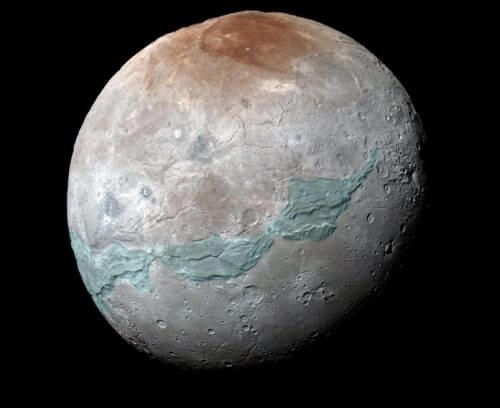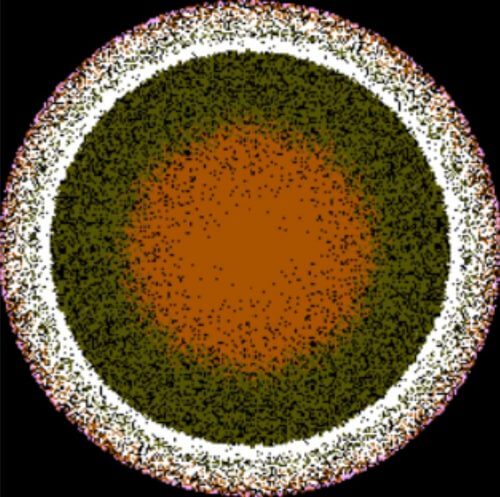Below the belt: Joint research by teams from the Technion andUCLA Shedding light on the formation of the tectonic belt surrounding Charon, the largest of Pluto's moons

Charon, the largest of Pluto's moons, was discovered in 1978 and has since aroused great curiosity due to its special properties. It orbits very close to Pluto and is only about 50% smaller than it, a fact that makes it the largest moon (relative to its planet) in the solar system.
In mid-July 2015, the New Horizons spacecraft (probe) passed near Pluto (about 12,600 km from it) and brought unprecedented images not only of Pluto but also of Charon. According to Associate Professor Hagi Peretz from the Faculty of Physics at the Technion, these images contained many surprises, including the existence of a tectonic belt surrounding Charon. Now, together with his colleague Dr. Uri Melmud from the Technion and Prof. Gerald Schubert from UCLA (University of California Los Angeles), Prof. Mishna Peretz publishes a hypothesis concerning the formation of the Charon Belt. The research, published in the journal Monthly Notices of the Royal Astronomical Society, provides a new model of the complicated thermal and physical evolution of Charon and contributes to the wider scientific debate concerning its formation and surface properties.
According to Prof. Mishna Peretz, scientists currently face several challenges studying this special moon: "First, a successful theory is needed to explain how Charon was formed. Second, we must characterize how it developed from its initial state to today. Now, in light of the high-quality images of its surface, we are faced with a third question: How are the characteristics of this surface related to Charon's formation and development? And of course - the issue of the belt photographed by New Horizons."
The tectonic belt
The images from New Horizons show a series of ravines and ridges that cover the area of Charon in the area near its equator and thus create a tectonic belt that stands out from the surface and also extends to the far half of the moon from Pluto - an area not photographed by the spacecraft. This belt separates two areas that are very different in character: the relatively smooth plains in the south and the more rugged areas in the north. in several places, and especially in the largest valley Serenity chasma Appearing in the photograph on the right side of the tectonic belt, it looks as if the surface of Charon has been torn away. "Our hypothesis," says Prof. Mishna Peretz, "is that the coffin underwent a gradual expansion that led to the tearing of its surface, and we have an explanation for this."
Like a bottle in the freezer
The expansion of other bodies in the solar system is explained by the freezing of an internal subterranean ocean. As a result of the expansion of the water upon freezing, pressure is exerted on the surface of the body, and at some point it may explode - similar to a glass bottle full of water stored in the freezer. There are researchers who believe that a similar thing happened to Charon: the ocean inside it froze and expanded. "The problem is," says Prof. Mishna Peretz, "that there is no proof that there was an inner ocean inside the coffin. That's why we offer an alternative explanation."

According to the explanation of the joint group for the Technion and UCLA, it was characterized as a cabinet in the past with a porous texture. Porosity is defined as the ratio between the space between the grains of the material and the net volume of the grains. Since its birth, hundreds of millions of years ago, Charon's porosity level has decreased and its compressibility has increased, as a result of several factors: warming (under the influence of its internal energy sources), gravity and rock-water reactions. Later the water separated from the rock and froze on the surface of Charon. This is the explanation for Charon's layered structure.
The tectonic belt is centered in the equatorial region of Charon, but is not completely parallel to it. This fact is also explained in the study that is now being published. According to one hypothesis, the belt formed around the old equatorial layer as a result of this region having a thinner or weakened crust as a result of the initial contraction of Charon; After the belt was formed, Charon's axis of rotation changed as a result of the collision, which is why the belt and the current equator do not coincide. This collision may also explain the geophysical difference between the two hemispheres (the hemisphere north of the belt versus the one south of it), as well as cryo-volcanic activity immediately after the collision. This study opens a new field of possible studies.
For the full article click here
